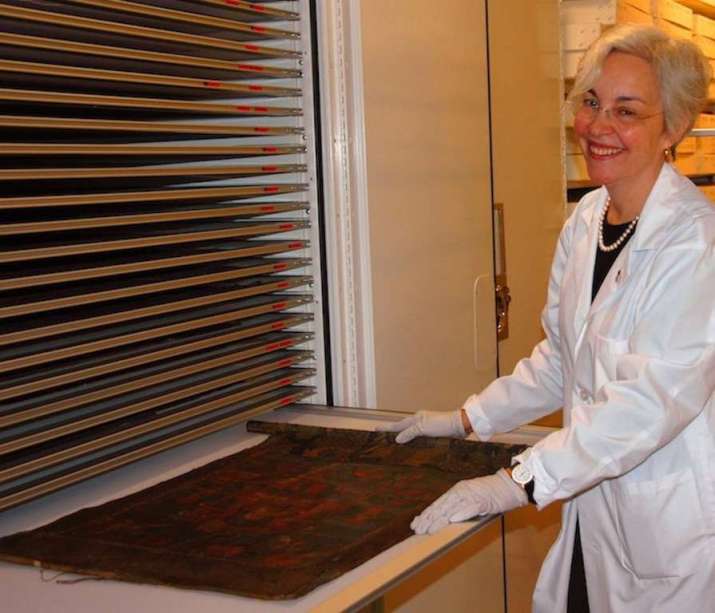FEATURES|THEMES|Commentary
Buddhistdoor View: A Devotional Approach to Preserving Buddhism’s Treasures
 Ann Shaftel at work. Image courtesy of Ann Shaftel
Ann Shaftel at work. Image courtesy of Ann ShaftelOver the past 48 years, conservator and consultant Ann Shaftel has posed a difficult question during interviews she had with many a great master, and with monks and nuns, thangka artists, and scholars: “Take a thangka that has been used in a monastery for many years and was featured in transmissions, empowerments, and has been blessed by many teachers. Say it ended up in Paris in a collector’s home, and the collector put it in their office space or living room, would it still maintain its sacred nature? Or, would it keep its sacred nature if it were collected by a museum and displayed in a sterile gallery without a contextual description?”
Shaftel is among the valuable (yet small) circle of trained thangka conservators who are also devoutly Buddhist. She works as a consultant for both the commercial art market, museums, and Buddhist monasteries/temples all over the world. Her approach to conservation differs from many conservators not just because it is strictly minimalist in its intervention, but also because the consecrated function of the object is taken into account. The religious history of a thangka as a sacred item is a fundamental property of it and must not be erased or embellished. This is an attitude to conservation that seems estimably “Buddhist,” and that conservators and collectors of Buddhist art should consider adopting.
Shaftel’s method takes into account that the holy or sacred is intangible, but that there are objects that function as tangible carriers of sacred/holy blessings. She aims to stabilize and preserve both the painting and its textual surroundings. “It wasn’t in the Himalayan tradition of preservation to clean [thangkas] so severely that one would remove the fine layers of the master painter’s work and repaint it so that it looks fresh, new, and attractive in an art museum or a collector’s house,” she told Buddhistdoor Global.
European oil paintings in the prestigious art galleries of the West are restored to a degree unheard of in traditional Himalayan art. This is because oil paintings have protective layers of varnish. Unfortunately, this approach to conservation is often also used when conserving thangkas in the contemporary art market. Thangkas, however, do not have a varnish layer and when restorers use the usual solvents (aqueous or non-aqueous) to remove “dirt and darkness” from the layers of paint, (which are composed of finely hand-ground pigments mixed with yak-hide glue), the topography of a thangka is completely altered.
“If you were to look over the topography of a traditional thangka it would be like flying over a landscape in a plane, with patches of hills and discernible landscapes across the piece. If you use the solvent-intensive cleaners that are appropriate for oil paintings, or the water-intensive treatment that is appropriate for Chinese and Japanese scroll paintings on thangkas, you’re creating something that is flat and has lost a basic quality of the original painting—and it can never be reversed.”
 Monks at Punakha Tsechu, Bhutan, unrolling a thangka representing the Shabdrung, for a yearly festival. From bhutanrebirth.com
Monks at Punakha Tsechu, Bhutan, unrolling a thangka representing the Shabdrung, for a yearly festival. From bhutanrebirth.comIt is the perfect, flawless aesthetic rather than its inherited function and history that has become a dominant concern in the art market today, which poses problems for living sacred objects like thangkas. Traditionally, a thangka that has been in the presence of great teachers for centuries is darkened by the smoke of butter lamps and has small accretions of offered substances. And rather than cleaning the artwork and making it looks as new, it would likely be hung in the rooms of monastery abbots or in storage for respectful safekeeping. To replace the thangka, a thangka painter would be called in to create a new thangka with the same iconography for use in the cycle of monastery meditations according to the lunar calendar.
Even today, with the various digitizing initiatives, there are items that temples and monasteries would like to keep “as is;” with evidence of its history, and the devoted conservator should respect this to the fullest. The most that might be done to those thangkas should be to stabilize their condition; to change as little as possible of its history and inheritance, while ensuring the survival of the thangka. It is crucial to try and avoid unnecessary deep “cleaning” and repainting.
This approach to stabilization-only and science-based preservation to avoid further damage to thangkas is taught in Treasure Caretaker Training “Preservation of Monastery Treasures” workshops in monasteries and nunneries across the Buddhist diaspora, some of which are taught by Shaftel. The emphasis on safer storage, theft prevention, and disaster preparedness seems eminently reasonable, given their primary use as holy ritual and meditative items rather than paintings to be looked at.
Preservers like Shaftel use the term “treasure” rather than “art” to counter the wave of commodification of Buddhist sacred material since the 1980s. “Collectible” art can be graded subjectively: on presentation, on cleanliness, and all the other standards to which secular art are held. To a Buddhist conservator (and indeed, to many traditionally minded Buddhists), the idea of sacred art being evaluated according to criteria that do not take into account the consecrated history of the item is troubling.
Fundamentally, a devotional conservator shares the same objective with a curator from a museum or art gallery, or a collector: the preservation of treasures. But we have learned that nuance is required. The very concept of preservation is loaded with different priorities and presuppositions that need to be negotiated and agreed upon by different parties who might have conflicting visions, before the actual conservation process can begin.
Perhaps it is just an ideal, but we hope that collectors and conservators reading this understand and potentially respect that preserving a sacred object, sometimes means simply documenting it, stabilizing it, without putting it on public display. How else can the entire life of the art, which continues to live on in its religious and functional significance, be respected to its fullest extent?
Please refer to www.treasurecaretaker.com for more information. Ann Shaftel also teaches thangka preservation seminars to museum staff and collectors.
References
Shaftel, Ann. 2008. “The Continuously Evolving Form of Thangkas.” In Proceedings of the Forum on the Conservation of Thangkas: Special Session of the ICOM-CC 15th Triennial Conference, New Delhi, India, September 26, 2008. Edited by Mary Ballard and Carole Dignard, 51. Delhi: International Council of Museums - Committee for Conservation.
See more
Meet Ann Shaftel, director and lead instructor of treasure caretaker training (Treasure Caretaker Training Digital Monastery Project)
Related features from Buddhistdoor Global
A Mission of Preservation: A Conversation with Prof. Luo Wenhua of the Palace Museum
Buddhistdoor View: A Tightrope between Conservation and Education














